Traction Control System, Stability Program, Anti-lock braking system, Alloy wheels, Climate control
Review car Bugatti Veyron
Bugatti Veyron 16.4, 2003
Bugatti Veyron 16.4 - the most expensive, most powerful and most fast car in the world, approved for use on public roads. Launched in production by the Volkswagen AG subsidiary, Bugatti Automobiles S. A.S., the unique car is sold under the legendary Bugatti brand, and it owes its name to Pierre Veyron, who won the 24-hour Le Mans race at the Bugatti in 1939.
The story of the creation of the supercar began with a demonstration at the 1999 Tokyo Motor Show the concept car EB 18/3 "Chiron" with a 6.3-liter 555-horsepower engine, built according to the formula W18 with three blocks of 6 cylinders. The design of the concept car was developed by the Italian studio ItalDesign Giorgetto Giugiaro (Giorgetto Giugiaro).
The first attempt was far from the ideal sports supercar that VW Chairman Ferdinand Karl Piëch wanted to see Bugatti. The car had a relatively weak, bulky engine, and the exterior was more luxurious than sporty.
At the 2001 Geneva Motor Show at Bugatti Automobiles S. A.S. A pre-production model was already exhibited under the new name Bugatti EB 16/4 Veyron. The car not only changed its name, almost everything was new, from an engine consisting of two V-shaped blocks of eight cylinders (a total of four blocks, 4 cylinders each) to an exciting sports body completely developed at Volkswagen by Helmut Warkuss (Hartmut Warkuss )
The start of mass production of the new model was scheduled for 2003, however, a number of circumstances significantly changed the timing. Ferdinand Pieha was replaced by Bernd Pischetsrieder as Chairman of the Volkswagen Group, and Thomas Bscher became President of Bugatti in December 2003, replacing Karl-Heinz Neumann. Despite personnel changes, work on the project did not stop, and in September 2005 the first production Bugatti Veyron 16.4 came out of the gates of the newly built factory in Molsheim, the old Bugatti family nest.
A car with a total production volume of no more than 300 copies costs 1 million euros and has the following characteristics: The W16 engine with four turbochargers is 7993 cm3. The gas distribution mechanism consists of 4 camshafts and 64 valves. Engine power, according to various estimates, ranges from 1020 - 1040 hp. (VW) up to 1006 - 1026 h.p. (SAE). For the avoidance of doubt, Bugatti Automobiles S. A.S. announced engine power of 1001 horsepower. The maximum torque is 1250 Nm and is transmitted to all four wheels through a double-disc clutch and Haldex clutch. The gearbox installed in the car is seven-speed; shifting is carried out by steering column levers. The transition to each subsequent transmission takes 0.2 seconds.
The maximum speed of the Bugatti Veyron, established during official tests on the Ehra-Lessien highway, was 407 kilometers per hour, the acceleration time to 100 km / h is 2.5 seconds, to 200 km / h - 7.3, and up to 300 - 16, 7 seconds
These achievements make the Bugatti Veyron not only the fastest car, but also the most dynamic production car in history. It also ranks first in fuel consumption, spending 125 liters per 100 kilometers when the throttle is fully open. The actual consumption in the urban cycle is 40.4 liters, in the mixed - 24.1, and on the highway - 14.7 liters per 100 kilometers.
The maximum speed for everyday use is 377 kilometers per hour. When the car reaches 220 km / h, the hydraulics lower the car until it reaches a clearance of 8.9 cm and at the same time a rear wing rises from the rear of the body, providing the necessary downforce. In order to develop maximum speed, the driver must use a special key to activate the high-speed driving mode, which, by the way, is electronically limited at 407 km / h, in order to avoid premature tire wear.
The Bugatti Veyron features unique ventilated carbon-ceramic brake discs and eight-piston calipers. At speeds above 200 km / h, when braking, a wing is activated, acting as an aerodynamic brake. The time to turn the wing to an angle of 70 degrees is 0.4 seconds after the start of braking. The time it takes a car racing at maximum speed for a full stop is 10 seconds, and the Bugatti Veyron does not shift when braking from a straight path, even if the driver releases the steering wheel.

Bugatti Veyron 16.4, 2005
Every year in the US state of California, in the small town of Pebble Beach, there is a show of classic and exclusive cars Concours d "Elegance. The most valuable cars of all time are brought here. Here, probably, the largest concentration of vintage Alfa Romeo, Bentley, Bugatti, Mercedes-Benz Ferrari per square meter. The owners are trying to bring them in perfect condition to get into the competition program and try to win the most prestigious competition. Indeed, among collectors this is considered the highest award. This year at Concours d "Elegance a full house: here zli elegant and rare cars produced in the last hundred years. But sometimes modern cars also come to Pebble Beach. As a rule, they correspond to the format of the event - these are rare and incredibly expensive sports or luxury models.
The current show was chosen for the presentation of the new version of the Bugatti EB16 / 4 Veyron - Grand Sport. The sports coupe was first introduced back in 2000, and then it was considered the next Bugatti concept. Nobody believed that they would decide to launch such an unusual car into mass production, and the leadership of Volkswagen, the owner of Bugatti, did not immediately agree to this. But for Veyron the chairman of the concern Ferdinand Piech stood up. He knows a lot about high-speed cars, since in the 1960s he developed the Porsche 917 - one of the best sports prototypes of all time. Time has shown that Peach was right: Veyron is well established. He was the first of serial cars to cross the threshold of 400 km / h. And even if the title of the fastest model on the planet has already been taken away from the coupe, he still has something to surprise. One after another, special versions appear - Pur Sang, Sang Noir, Par Hermes.
They differ from the base model only in the level of equipment, and the novelty presented at Concours d "Elegance differs more radically. After all, the Grand Sport is a Targa, the first modern Bugatti with a removable roof. And it again claims to be a speed record - now among serial convertibles.
Design Bugatti EB16 / 4 Veyron can be attributed to modern classics. It clearly shows the motives of famous ancestors - the Bugatti of the 1930s, which are considered the standard of style of those years and an object to follow. A symbol of the succession of generations is the horseshoe-shaped radiator grille, which was invented by Ettore Bugatti himself at the beginning of the last century. And on the sides it is surrounded by quite modern headlights and air vents. As if from the pre-war time, a sloping hood and slots on the sidewalls were transferred to Veyron.
The door handles and gas tank hatch are chrome-plated, as are the huge 20-inch wheels. By the way, Veyron tires are the widest that are available for car - 265 mm in front and 365 mm in back. Designed them specifically for the Bugatti. With modern retro style modern wing is well combined. There are two of them, and one of them acts as an air brake. And behind the front, when viewed from above, you can see the pride of Veyron - its huge engine
The most important innovation of Grand Sport is a transparent polycarbonate top, which can be moved if necessary. Electronics controls this procedure, and it can be carried out at speeds up to 130 km / h. To prevent the driver and passenger from interfering with the wind, the windshield was slightly increased. Since the roof in the compartment is part of the monocoque power structure, its absence significantly reduces the rigidity of the body. Therefore, the engineers had to strengthen the design, primarily in the area of \u200b\u200bthresholds and the transmission tunnel.
The thickness of the rear pillars was increased due to additional carbon inserts, and a special carbon fiber plate was added to the bottom. Special longitudinal beams appeared in the doors, which, in a collision, distribute the impact force from the front to the rear pillars. Rooftop air intakes are also reinforced with 10-centimeter carbon elements, and now they protect against overturning. All these improvements have increased the mass of the car by 80 kg - up to 1968 kg. The installation of a new roof did not affect the height of the car, which is equal to 1204 mm - as much as the coupe. The length is 4462 mm, the width is 1998 mm, and the wheelbase is 2710 mm.
The interior of the Veyron is somewhat reminiscent of the trim of the famous Bugatti 57 SC Atlantic and 41 Royale. Inside, the car is almost completely lined with chocolate-colored leather. Where it is not, shiny polished aluminum is provided. They completely decorated the center console, reminiscent of the instrument panel of the aircraft. Metal inserts are also present on the steering wheel and in the doors. The driver and passenger are offered a choice of soft luxurious or sports seats. They are separated by an incredibly wide central tunnel. The developers fundamentally abandoned modern digital devices and installed classic dials in the style of old racing cars.
Among them is an unusual sensor that shows engine power - probably so that the driver does not forget what he is dealing with. A partition separates the interior from the 8.0-liter W16 with four turbochargers. The Bugatti drives a herd of one thousand and one horses, which peak at 6,000 rpm. The maximum torque is 1250 Nm at 2200-5500 rpm. Grand Sport is able to accelerate to 100 km / h in 2.7 s, and after 16.7 s on the speedometer is already 300 km / h. The car's limit is 407 km / h, but with the roof removed, you can travel at a speed of no more than 360 km / h. By the way, to accelerate to the maximum, the car needs a separate key, the rotation of which should unlock the ultra-fast driving mode. At high speeds, fuel consumption reaches 78.3 l / 100 km! In the urban cycle, it is 41.9 l / 100 km, on the highway - 15.6 l / 100 km, and in the combined cycle - 24.9 l / 100 km.
The gears in the DSG 7-speed dual-clutch transmission shift in 150 milliseconds. Torque is transmitted on both axles: Veyron is an all-wheel drive. The car is equipped with an active suspension with variable ground clearance. In the normal state, the clearance is 125 mm, and at speeds above 220 km / h - 80 mm. If you continue acceleration to 375 km / h, then it will decrease to 65 mm. In this case, the drag coefficient Cx improves from 0.39 to 0.36. With great speed, only carbon-ceramic brakes can stop the car. The diameter of the front discs reaches 400 mm, they are equipped with four pads at once. Rear 380 mm received two pads. Thanks to them, the braking distance from 100 km / h is only 31.4 m.
The Bugatti EB16 / 4 Veyron is a rare exclusive, and the Grand Sport will be released even less. The number of cars is limited - 150 pieces, and 50 of them will be sold to Bugatti fans, in the garage of which there is more than one car of this brand. Therefore, collectors have already begun the hunt for the Grand Sport. The first copy was sold at a charity auction in Pebble Beach for $ 2.9 million. The remaining potential buyers will have to wait until March and prepare 1.4 million euros - that is how much Targ will cost in Europe.
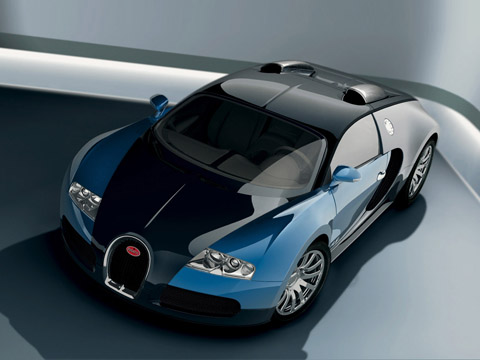
Bugatti Veyron 16.4, 2008
when at the beginning of the millennium introduced the conceptual version of the Bugatti Veyron 16.4, few expected to see its serial version. But the efforts of the head of the board of Volkswagen concern Ferdinand Piha gave their result. Dr. Pih seriously took to revive the Bugatti, and in 2005 began production of a super-powerful 1001-horsepower coupe. Veyron immediately confirmed in practice its application for the title of the fastest production car on the planet - it developed 408 km / h. However, two years later, this record fell: the American SSC Ultimate Aero TT was able to reach 412 km / h. Bugatti specialists firmly decided to regain their first position in the ranking of the most fast cars and created the more advanced Veyron 16.4 Super Sport.
"Live" to see the novelty was possible at the show of classic and exclusive cars in Pebble Beach (USA). Thus, Bugatti began a peculiar tradition - to present new modifications at this exhibition. Indeed, last year it was in this California town that the Targa Veyron Gran Sport was shown. This shows a certain continuity of generations, since the famous forefathers - the ancient Bugatti of the 20-30s are always present nearby.
The main changes in the Veyron 16.4 Super Sport has undergone an 8.0-liter W16 engine. Thanks to four modified turbochargers and intercoolers, power has risen to an incredible 1,200 liters. from. During tests at an ultra-high-speed circuit near Wolfsburg (Germany), the Veyron 16.4 Super Sport developed 431 km / h in two attempts and exceeded the expectations of even its creators. Invited representatives of the Guinness Book of Records on the spot officially confirmed the new record. The car is fully consistent with the production model, however, on the road Bugatti decided to install a speed limiter at around 415 km / h to save tires.
As before, the coupe is equipped with a 7-speed transmission with two clutches, and permanent all-wheel drive helps to cope with the enormous torque (1500 N · m). Changed the chassis of the car. In particular, the engineers slightly increased the suspension travel, installed new shock absorbers and anti-roll bars. They allow you to achieve lateral acceleration of 1.4 g. The Bugatti is equipped with an active suspension with variable ground clearance. In the normal state, it is 125 mm, at a speed of over 220 km / h - 80 mm, and at 375 km / h - 65 mm. Stop Veyron called carbon-ceramic brake discs with a diameter of 400 mm.
The novelty retains the familiar style in which features of the Bugatti of the 30s are visible, such as a horseshoe-shaped false radiator grille or stamped “seams” on the roof and hood. The new aerodynamic package helps distinguish Super Sport from the standard Veyron. In the front bumper, increased air intakes and added a more efficient spoiler. New door sills appeared on the thresholds, and a double diffuser appeared on the rear (as in the latest Formula 1 cars). In addition, the “stern” emphasize the large rectangular exhaust pipes. The engine was covered with a special streamlined cover with two additional air intakes. At high speeds, a huge wing rises, and when slowed down, it changes the angle of attack and turns into an air brake.
Salon is made in more contemporary style. The classic polished aluminum has been replaced by carbon in the center panel and door trim. The steering wheel is decorated with the same material, and its rim is trimmed with suede. Orange accents and seams dilute dark tones. The instrument cluster consists not only of a traditional speedometer, tachometer, boost pressure indicators or fuel level, but also an engine power sensor. The seats of the car were decorated with Super Sport inscriptions - probably so that the owner did not forget which Veyron he was driving.
In five years, they manufactured about 300 Bugatti Veyron coupes and convertibles, which can be considered a good result for such an expensive model. Super Sport promises to be a rare bird: only 30 such cars will be produced at a price of about 1.5 million euros. This modification will be a farewell version of Veyron, because its production will cease soon. Next in line is the Bugatti 16C Galibier luxury sedan and, possibly, an even faster coupe.

Bugatti Veyron 16.4, 2005
No joke - the Bugatti Veyron coupe has a power of 1,001 hp. and accelerates to 100 km / h in 2.5 seconds! That is, the acceleration sensation in the Veyron is much more exciting than in a passenger jet. But the Grand Sport roadster, built on the basis of the Veyron coupe, turned out to be an even more incendiary car. To create an industrial version of Veyron, Bugatti engineers had to build 27 prototypes. For the Grand Sport roadster, nine were enough, which were divided into three series. In July, Bugatti launches the production of the serial Grand Sport, but the intermediate version 2.1 was presented to reporters.
“Do you hear something creaking behind the driver’s door?” - says Pierre-Henri Rafanel, a regular Bugatti autopilot, who is involved in car refinement. - The quality of the picture from the rear view camera does not suit us either, as well as defects in the leather upholstery of the dashboard. All these shortcomings in serial cars will not be. " However, in my opinion, these defects are now completely invisible.
If the Bugatti Grand Sport has a rigid removable carbon fiber roof, the car is almost indistinguishable from the Veyron coupe.
But the technical differences between the cars are quite significant. First of all, this applies to the carbon fiber monocoque, which had to be redesigned, because the rigidity of the car body with and without a roof is completely different. If the designers did not begin to change the structure of the body, in a head-on collision the roadster would simply fold in half, flattening the riders. To avoid this, engineers also had to replace the aluminum doors of the Veyron coupe with carbon-fiber with horizontal crossbars in the Grand Sport. Thus, in a collision, the body is deformed, but the monocoque remains unharmed - as proved by crash tests.
By the way, in the four years since the start of the Bugatti Veyron, about 250 of the 300 cars planned for production have been sold. During this time, only three accidents involving Veyron were recorded (in which no one was hurt). In Japan, during a test drive, the journalist lost control (next to him was not a professional pilot, but an insufficiently experienced employee of the Bugatti dealer). In the UK, the brother of the owner of Bugatti Veyron decided to drive a car in the absence of the owner. To his misfortune, it rained that day - and the unfortunate racer “lost” the Bugatti Veyron on the wet road. “The owner called and cried, asked to fix it as soon as possible,” says a Bugatti spokesman. -
After all, he had been waiting for the car for a year and almost immediately lost it. But it took us several months to make a new monocoque to replace the damaged one, because this is a piece-wise and very complicated production. ” And one of the American buyers of Bugatti Veyron was not even more fortunate: having received a message that the car had arrived in the United States and had already been sent to the address of the owner, the newly-minted owner called the full guest house and had a grand party. But that night, they did not wait for the car: the driver of the trailer carrying the Bugatti Veyron fell asleep at the wheel, and the truck rolled over.
Even after hearing such stories, I get behind the wheel of the Grand Sport without much fear - the memories from a test drive of the Veyron coupe two years ago are still fresh in my memory. Then, to demonstrate the capabilities of the car, Rafanel showed me a spectacular trick: he accelerated the compartment to 200 km / h and braked “to the floor”, while removing his hands from the steering wheel. Veyron stopped dead in his tracks, not even a centimeter off the trajectory. So I know: Veyron can do a lot, but it can also forgive a lot for a self-confident (or insecure) driver.
On the day of the test in Sardinia, where we tested the car, the sun was shining, so the removable roof was removed once and for all. You won’t be able to take it with you in case of bad weather: you can’t fit it in the 38-liter front trunk. Therefore, to protect against rain, Grand Sport designers came up with a simple but effective move: a folding rectangular umbrella (on a carbon fiber frame) that can be fixed in place of a rigid roof and thus travel at a speed of up to 160 km / h.
The engine in the Bugatti starts in two steps: first you need to turn the key in the ignition, then press the Start button. And behind your back, a 16-cylinder monster with four turbochargers comes to life, developing a torque of 1250 Nm in the range of 2200-5500 Nm. The compartment has excellent sound insulation, so the engine is almost inaudible. As it turned out, riders lose very, very much. Because the sound of the Bugatti engine (it is placed on the roadster exactly the same as on the coupe - without the slightest change, including in the exhaust system) can be sold separately, organizing its solo performances. When the driver stops acceleration and takes his foot off the gas pedal, the engine exhales: “Uff!” - this system relieves excessive pressure. And when the car accelerates, the engine sings with an excellent baritone, not trying to break into a scream even at the most intense acceleration.
And the voice of the engine does not bother at all: I spent about five hours driving the Grand Sport, drove several hundred kilometers - and in my ears it did not buzz, but my head remained clear. Because the Grand Sport interior was surprisingly well protected from turbulence in airflows (the windshield in the roadster is installed at the same angle as in the coupe, but it has become several centimeters longer). So even at speeds up to 150 km / h in Grand Sport you can talk without raising your voice, and upon reaching this mark the system will automatically close the side windows.
The declared maximum speed for the roadster is the same as for the coupe - 407 km / h (in order to exceed the speed of 375 km / h, a second "secret" key is required); Rafanel says that on prototypes of the Grand Sport with a retracted roof, it accelerated to 320 km / h - “that's enough,” the race car driver says (the declared maximum speed of a car without a roof is 360 km / h). By the way, the fuel consumption of the Bugatti is not terrible for an engine of such volume and power: the on-board computer showed me that over the past 1783 km of run, it amounted to 26.6 liters at an average speed of 45 km / h. True, when driving at a speed of about 400 km / h, consumption increases to 100 liters per 100 km, says Rafanel.
As with the Bugatti coupe, the roadster design teeters on the brink of profitability. In the development of the Grand Sport, according to Rafanel, tens of millions of dollars were invested; In total, 150 Grand Sport cars will be built, while the roadster is only 200 thousand euros more expensive than the coupe (1.4 million euros compared to 1.2 million euros excluding taxes). If I had the opportunity to choose between a roadster and a coupe, I would have chosen the first without hesitation. Because in a compartment you can revel in speed, but you do it separately from the car: an unknown force carries you forward, but you don’t really hear and understand what is happening. In the compartment, I easily reached 280 km / h, in the roadster on the picturesque paths of the Costa Smeralda resort area it was unlikely to accelerate faster than 200 km / h. But in Grand Sport, thanks to the song of the motor and the wind, you feel unity with the car and the skin, you feel how you cut space and time together. Unforgettable impression! Thanks to Volkswagen Group Chairman and Engineer Ferdinand Piech for daring to create the Bugatti Veyron, a great car that is unlikely to make VW profit.
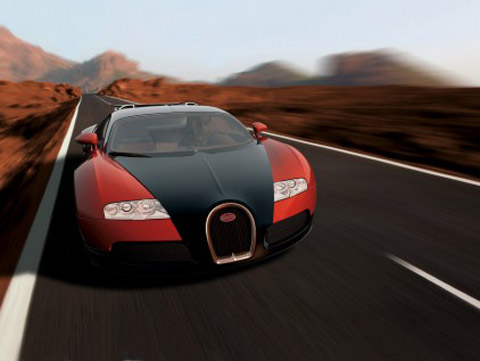
Bugatti Veyron (Bugatti Veyron) - The most expensive, most powerful and fastest car in the world, approved for use on public roads. Launched by Volkswagen AG - Bugatti Automobiles S. A.S.unique car sold under the legendary brand Bugatti, and his name is obliged Pierre Veyronwinning on Bugatti Le Mans 24 hour race in 1939.
The story of the creation of the supercar began with a demonstration at the 1999 Tokyo Motor Show the concept car EB 18/3 "Chiron" with a 6.3-liter 555-horsepower engine, built according to the formula W18 with three blocks of 6 cylinders. The design of the concept car was developed by the Italian studio ItalDesign Giorgetto Giugiaro (Giorgetto Giugiaro).
The first attempt was far from the ideal sports supercar I wanted to see Bugatti Volkswagen Chairman Ferdinand Karl Pi? ch. The car had a relatively weak, bulky engine, and the exterior was more luxurious than sporty.
At the 2001 Geneva Motor Show Bugatti Automobiles S. A.S. a pre-production sample was already exhibited under a new name Bugatti EB 16/4 Veyron. The car not only changed its name, almost everything was new, from an engine consisting of two V-shaped blocks of eight cylinders (a total of four blocks, 4 cylinders each) to an exciting sports body completely developed at Volkswagen by Helmut Warkuss (Hartmut Warkuss )
The start of mass production of the new model was scheduled for 2003, however, a number of circumstances significantly changed the timing. Ferdinand Pieha was replaced by Bernd Pischetsrieder as Chairman of the Volkswagen Group, and Thomas Bscher became President of Bugatti in December 2003, replacing Karl-Heinz Neumann. Despite personnel changes, work on the project did not stop even in September 2005 from the gates of the newly built factory in Molsheim, an old family nest Bugattifirst serial Bugatti veyron 16.4.
A car with a total production volume of no more than 300 copies costs 1 million euros and has the following characteristics: The W16 engine with four turbochargers is 7993 cm3. The gas distribution mechanism consists of 4 camshafts and 64 valves. Engine power, according to various estimates, ranges from 1020 - 1040 hp. (VW) up to 1006 - 1026 h.p. (SAE). To avoid misunderstanding, Bugatti Automobiles S. A.S. announced engine power of 1001 horsepower. The maximum torque is 1250 Nm and is transmitted to all four wheels through a double-disc clutch and Haldex clutch. The gearbox installed in the car is seven-speed; shifting is carried out by steering column levers. The transition to each subsequent transmission takes 0.2 seconds.
Top speed Bugatti Veyronestablished during official tests on the Ehra-Lessien highway amounted to 407 kilometers per hour, acceleration to 100 km / h is 2.5 seconds, up to 200 km / h - 7.3, and up to 300 - 16.7 seconds.
These achievements make Bugatti veyron not only the fastest car, but also the most dynamic production car in history. It also ranks first in fuel consumption, spending 125 liters per 100 kilometers when the throttle is fully open. The actual consumption in the urban cycle is 40.4 liters, in the mixed - 24.1, and on the highway - 14.7 liters per 100 kilometers.
The maximum speed for everyday use is 377 kilometers per hour. When the car reaches 220 km / h, the hydraulics lower the car until it reaches a clearance of 8.9 cm and at the same time a rear wing rises from the rear of the hull, providing the necessary downforce. In order to develop maximum speed, the driver must use a special key to activate the high-speed driving mode, which, by the way, is electronically limited at 407 km / h, in order to avoid premature tire wear.
On Bugatti Veyron there are unique ventilated carbon-ceramic brake discs and eight-piston calipers. At speeds above 200 km / h, when braking, a wing is activated, acting as an aerodynamic brake. The time to turn the wing to an angle of 70 degrees is 0.4 seconds after the start of braking. The time it takes a car racing at maximum speed for a full stop is 10 seconds, moreover Bugatti veyron does not shift when braking from a straight path, even if the driver releases the steering wheel.
Bugatti Veyron 16.4 - the most expensive, most powerful and fastest car in the world, approved for use on public roads. Launched in production by the Volkswagen AG subsidiary, Bugatti Automobiles S. A.S., the unique car is sold under the legendary Bugatti brand, and it owes its name to Pierre Veyron, who won the 24-hour Le Mans race at the Bugatti in 1939.
The story of the creation of the supercar began with a demonstration at the 1999 Tokyo Motor Show the concept car EB 18/3 "Chiron" with a 6.3-liter 555-horsepower engine, built according to the formula W18 with three blocks of 6 cylinders. The design of the concept car was developed by the Italian studio ItalDesign Giorgetto Giugiaro (Giorgetto Giugiaro).
The first attempt was far from the ideal sports supercar that VW Chairman Ferdinand Karl Piëch wanted to see Bugatti. The car had a relatively weak, bulky engine, and the exterior was more luxurious than sporty.
At the 2001 Geneva Motor Show at Bugatti Automobiles S. A.S. A pre-production model was already exhibited under the new name Bugatti EB 16/4 Veyron. The car not only changed its name, almost everything was new, from an engine consisting of two V-shaped blocks of eight cylinders (a total of four blocks, 4 cylinders each) to an exciting sports body completely developed at Volkswagen by Helmut Warkuss (Hartmut Warkuss )
The start of mass production of the new model was scheduled for 2003, however, a number of circumstances significantly changed the timing. Ferdinand Piech as Chairman of the Volkswagen Group was replaced by Bernd Pischetsrieder, and in December 2003
Thomas Bscher became president of Bugatti, replacing Karl-Heinz Neumann. Despite personnel changes, work on the project did not stop, and in September 2005 the first production Bugatti Veyron 16.4 came out of the gates of the newly built factory in Molsheim, the old Bugatti family nest.
A car with a total production volume of no more than 300 copies costs 1 million euros and has the following characteristics: The W16 engine with four turbochargers is 7993 cm3. The gas distribution mechanism consists of 4 camshafts and 64 valves. Engine power, according to various estimates, ranges from 1020 - 1040 hp. (VW) up to 1006 - 1026 h.p. (SAE). For the avoidance of doubt, Bugatti Automobiles S. A.S. announced engine power of 1001 horsepower. The maximum torque is 1250 Nm and is transmitted to all four wheels through a double-disc clutch and Haldex clutch. The gearbox installed in the car is seven-speed; shifting is carried out by steering column levers. The transition to each subsequent transmission takes 0.2 seconds.
The maximum speed of the Bugatti Veyron, established during official tests on the Ehra-Lessien highway, was 407 kilometers per hour, the acceleration time to 100 km / h is 2.5 seconds, to 200 km / h - 7.3, and up to 300 - 16, 7 seconds
These achievements make the Bugatti Veyron not only the fastest car, but also the most dynamic production car in history. It also ranks first in fuel consumption, spending 125 liters per 100 kilometers when the throttle is fully open. The actual consumption in the urban cycle is 40.4 liters, in the mixed - 24.1, and on the highway - 14.7 liters per 100 kilometers.
The maximum speed for everyday use is 377 kilometers per hour. When the car reaches 220 km / h, the hydraulics lower the car until it reaches a clearance of 8.9 cm and at the same time a rear wing rises from the rear of the body, providing the necessary downforce. In order to develop maximum speed, the driver must use a special key to activate the high-speed driving mode, which, by the way, is electronically limited at 407 km / h, in order to avoid premature tire wear.
The Bugatti Veyron features unique ventilated carbon-ceramic brake discs and eight-piston calipers. At speeds above 200 km / h, when braking, a wing is activated, acting as an aerodynamic brake. The time to turn the wing to an angle of 70 degrees is 0.4 seconds after the start of braking. The time it takes a car racing at maximum speed for a full stop is 10 seconds, and the Bugatti Veyron does not shift when braking from a straight path, even if the driver releases the steering wheel.

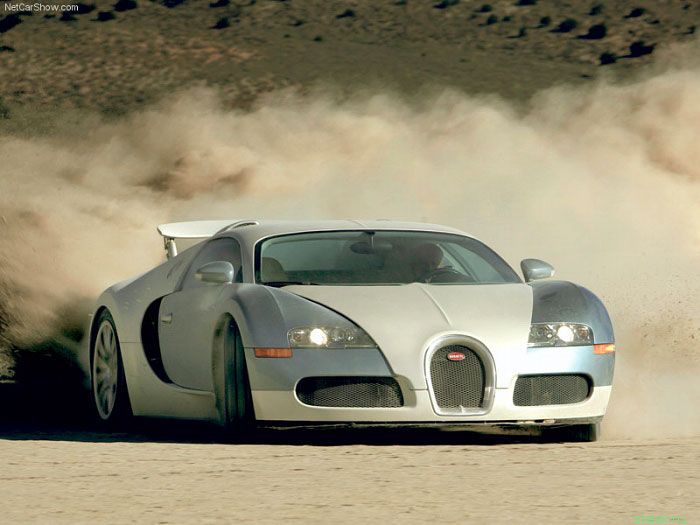

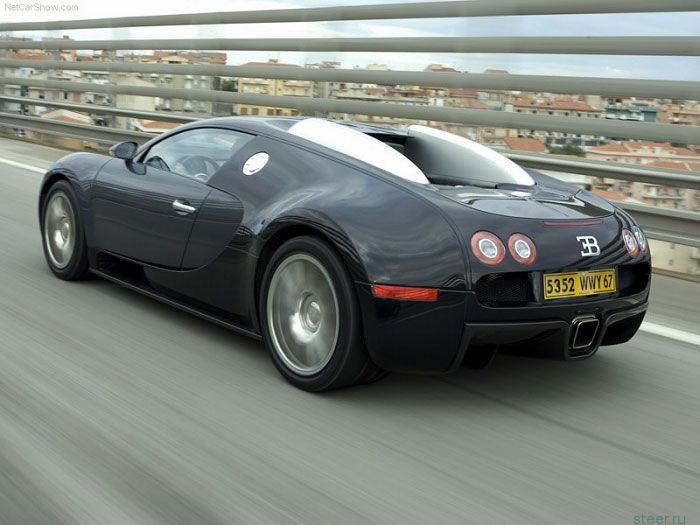



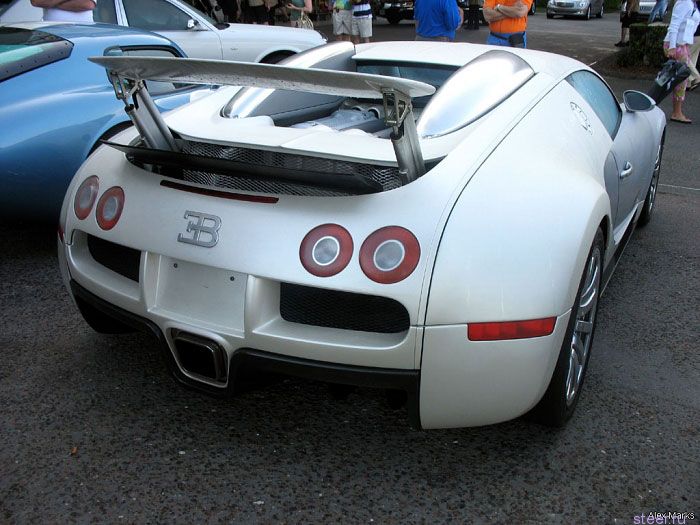





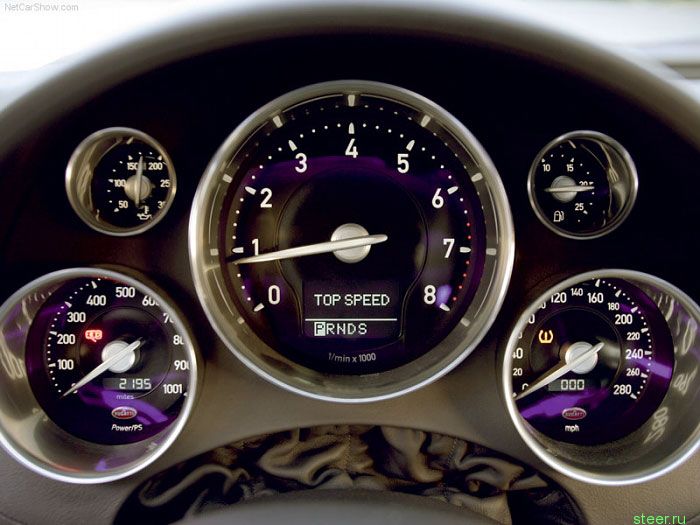
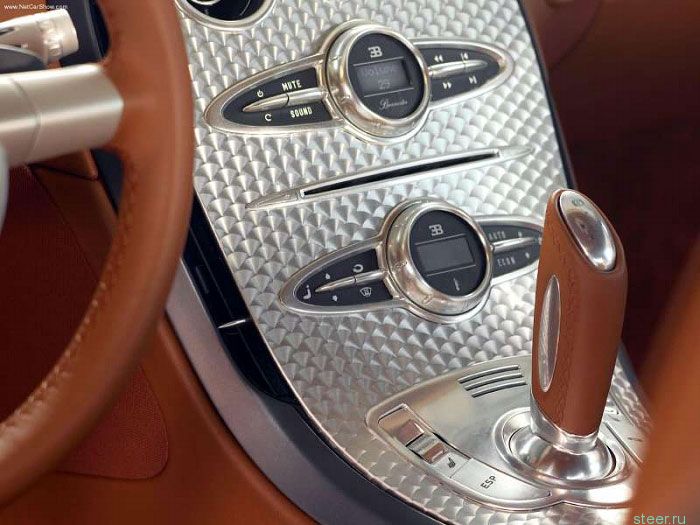
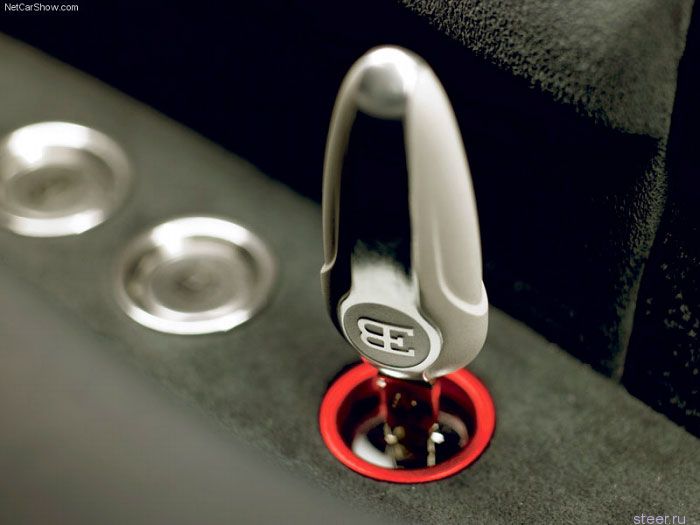


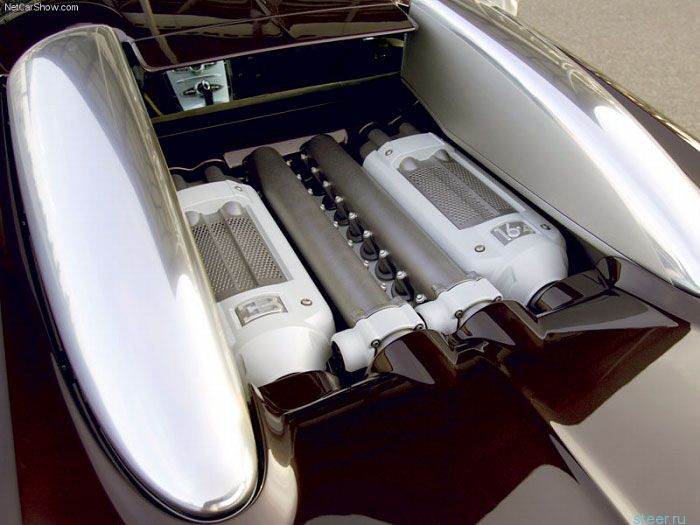

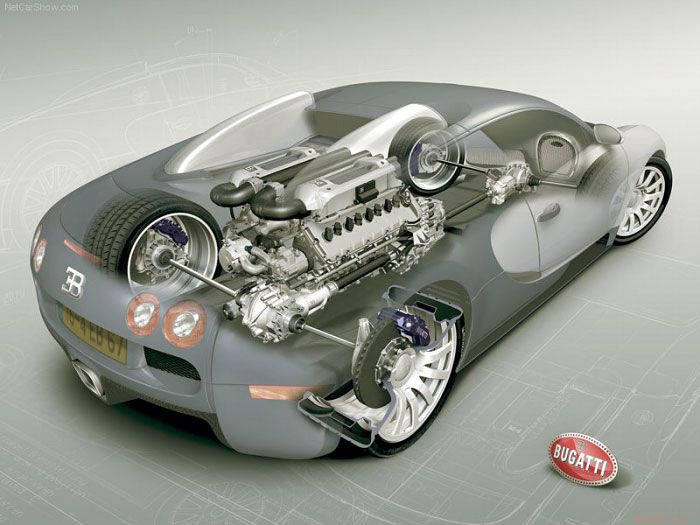
Probably every young man dreams of such a car that will rush faster than the wind along the deserted roads of the night city. One such vehicle model is the Veyron from the French automobile concern Bugatti. For the first time the Bugatti Veyron was introduced to the general public in 2005 and even then this real steel monster established itself as the fastest car in the world. This title was retained by the Bugatti Veyron to this day: according to the test drives, the car is capable of developing 431 km / h.
Vehicle Dimensions
The French engineers in the development of the Bugatti Veyron tried to reduce the weight of the car to the maximum and they succeeded: the weight of the vehicle is only 1950 kilograms, of which the majority belongs to the engine. The length of the car is 4462 mm, the width of the body reaches 1998 mm, and the height is 1204 mm. The length of the wheelbase is 2710 mm. Quite decent dimensions for sports car. The volume of the gas tank, which can accommodate 100 liters of fuel, is also amazing.
Specifications
The capabilities of this car are truly amazing and breathtaking. Under the hood of the Bugatti Veyron is a true 16-cylinder injector steel monster, capable of delivering 1001 horsepower at a peak torque value of 1250 Nm and 6000 rpm. This powerful gasoline power unit was designed from the ground up and is wholly owned by Bugatti. The seven-speed automatic transmission developed by the Bugatti engineering department specifically for this power unit is equipped with an incredible engine.
Bugatti Veyron possesses amazing dynamic characteristics. To the first hundred, the car accelerates in just 2.5  seconds. However, driving this car is not cheap: when traveling on mixed terrain, fuel consumption is 24.1 liters, when driving on highways, in conditions with no traffic jams, for a 100 km Bugatti Veyron you need only 14.7 liters, but when urban driving gasoline consumption rises to 40.4 liters.
seconds. However, driving this car is not cheap: when traveling on mixed terrain, fuel consumption is 24.1 liters, when driving on highways, in conditions with no traffic jams, for a 100 km Bugatti Veyron you need only 14.7 liters, but when urban driving gasoline consumption rises to 40.4 liters.
The car was designed with all-wheel drive suspension with front and rear multi-link independent axle. Both axles are equipped with independent ceramic brakes, with reinforced discs and equipped with a ventilation system, providing the vehicle with excellent braking performance.
If the vehicle’s speed exceeds 200 km / h, then when braking, an automatic wing activates, acting as an additional aerodynamic brake. Thus, when driving on maximum speed the car will stop completely in just 10 seconds.
The car is driven by a hydraulic steering wheel, providing the car with excellent softness and good stability when driving at high speeds.
Options and prices
 As you can guess from the specifications, the Bugatti Veyron is not for everyone. Only wealthy connoisseurs of strength and speed can afford it, since the cost of Veyron varies from 1.5 to 2.5 million euros, depending on the modification. In addition, car maintenance is also quite expensive, since the engine runs only on A-98 gasoline.
As you can guess from the specifications, the Bugatti Veyron is not for everyone. Only wealthy connoisseurs of strength and speed can afford it, since the cost of Veyron varies from 1.5 to 2.5 million euros, depending on the modification. In addition, car maintenance is also quite expensive, since the engine runs only on A-98 gasoline.
The exterior design fully justifies the cost of the car. The highest quality cow leather is used in the interior of the car, as Bugatti breeds calves raised in the alpine mountains.
In October 2005, a significant event took place in the history of the automotive industry - at the Tokyo International Motor Show, the premiere of the Bugatti Veyron serial hypercar literally “thundered”, which at the time of its appearance became the “most” in all respects: the most powerful, the fastest, the most expensive.
However, the history of the car began in the fall of 1999, when the EB 18/3 Chiron concept debuted in the capital of the country of the Rising Sun, followed in the spring of 2001 by a pre-production model under the name Bugatti 16.4 Veyron, presented at the Geneva shows.
In August 2008, at the American elegance competition in Pebble Beach, an open version of the hypercar appeared before the public “live”, which received the prefix “Grand Sport” and already went into production in 2009.
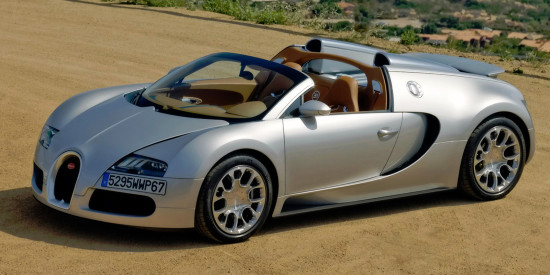
A new milestone in the “career” of the two-door began in July 2010, when the Bugatti revealed an even more capable modification of the Veyron called “Super Sport”, which not only pumped the engine, but also reconfigured the chassis and improved aerodynamics.
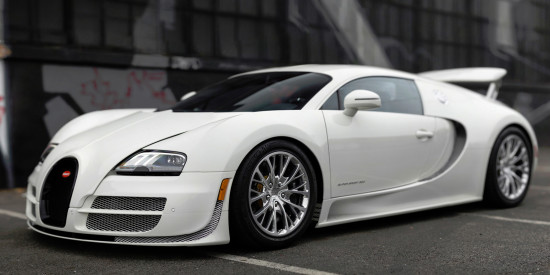
Well, in the spring of 2012, such a metamorphosis overtook the roadster, which received the designation "Grand Sport Vitesse".

In the spring of 2015, the Bugatti held its retirement automobile “icon”, presenting a “farewell” version of the open Grand Sport Vitesse “La Finale” at the Geneva show. In just ten years of production, 450 hypercars were born: 300 coupes (30 of them - in the 1,200-horsepower version) and 150 roadsters.

Appearance Bugatti Veyron will not leave anyone indifferent - the car can hardly be called a standard of beauty, but it instantly attracts attention and makes an indelible impression on its appearance. The wide and squat body of the hypercar, resting on wide “rollers” with a diameter of 20 inches, boasts not only muscular build and smooth outlines, but also aerodynamically calibrated forms.
Regardless of the version, the Veyron extends 4462 mm in length, and its width and height fit in 1998 mm and 1204 mm, respectively. Wheel pairs at the car are spaced at a distance of 2710 mm, and the ground clearance in the standard form is 120 mm (for 1200-strong versions - 99 mm). At the same time, at high speeds, the hypercar is able to “squat” by 50 mm - its minimum clearance reaches 65 mm.
The interior of the Bugatti Veyron is dominated by rigor, solidity and conciseness, however, by modern standards, the decoration of the two-door seems old-fashioned and looks very boring - you will not find any touch screens or other gadgets here, but the perfection of shapes and lines, which is mired in a luxurious design and impeccable quality, prevails. Dial gauges with a tachometer at the head, a beautiful three-spoke steering wheel and a sloping console on which analog clocks, “turbines” of ventilation deflectors and stylish audio and microclimate units are “written” - there is nothing inside that could distract from the road at high speeds. The "apartments" of the car show off chic finishing materials: aluminum, thick leather, varnished carbon fiber - this is all real.

Inside the Veyron’s cabin are two bucket seats with a bright side profile, carbon fiber base and mechanical adjustments. For luggage in front of the cabin, a luggage compartment is organized, but it is more formal - you can fit in there only one sports bag, and even then not every one.
Specifications. The most impressive thing about the Bugatti Veyron is not the exterior or the interior, but the gasoline engine installed longitudinally within the wheel base with the flywheel forward, devoid of any newfangled tricks, the power of which is digested by a 7-speed DSG robotic gearbox with two clutches.

All modifications of the hypercar "flaunt" all-wheel drive transmission with Haldex electromagnetic clutch, capable of directing up to 90% of traction to the front axle, and a rear differential with self-locking (up to 100%). On dry pavement, the moment is distributed between the wheels at a ratio of 45:55 in favor of the rear.
- By default, the car (including the “Grand Sport” roadster) is equipped with a grandiose 8.0-liter (7993 cubic centimeters) W16 engine, as if composed of a pair of “displaced-row” “eights” of a W-shape, with distributed injection, four turbochargers , 64-valve assembly, dry sump lubrication technology and two gas pumps. The "heart" of the car generates 1001 horsepower at 6000 rpm and 1250 Nm of torque at 2200-5500 rpm.
The coupe is “teleported” from standstill to 100 km / h after 2.5 seconds, and spends 7.3 and 16.7 seconds, respectively, for acceleration to 200 and 300 km / h. The maximum speed of the two-door reaches 407 km / h (moreover, in order to conquer such figures at 375 km / h it is necessary to run the “high-speed” mode), and its “appetite” in the mixed mode fits into 24.1 liters (though the consumption depends on the speed of movement).
The open version picks up the first “hundred” 0.2 seconds slower, and its peak of possibilities can change: without a roof, the car exchanges 360 km / h, with a soft top - not more than 130 km / h, and with a hard “coating” - 407 km / h . In combined conditions, the “Frenchman” destroys 24.9 liters of fuel per 100 km of track. - The Super Sport and Grand Sport Vitesse versions are “armed” with the same engine, but equipped with more efficient turbochargers (pressure raised from 1.3 to 1.5 bar), an upgraded intake system, enlarged liquid intercoolers and four gas pumps. As a result, its potential was brought up to 1200 “stallions” at 6400 rpm and 1500 Nm of ultimate thrust at 3000 rpm.
Super Sport conquers 415 km / h as much as possible (speed is limited to prevent rapid tire wear), eating 23.1 liters in the combined cycle, and Vitess - 410 km / h. From “standstill” to “hundreds”, it “shoots” after 2.5 seconds, up to 200 km / h - 6.7 seconds, and up to 300 km / h - 14.6 seconds (the roadster is slower by 0.1, 0.4 and 1.4 seconds, respectively).
The “Veyron” is based on a monocoque made of carbon fiber, weighing only 110 kilograms, to which an aluminum subframe with a running gear and a front final drive is connected to the front, and a steel subframe that houses the power unit on the back. The wings and doors of the hypercar are made of “winged metal”, and the covers of the engine and intercoolers are made of magnesium. In the “marching” form, the mass of the two-door has 1888 kg (weight distribution is almost perfect - 45:55).
The car "in a circle" is equipped with an independent chassis on double wishbones with passive Sachs shock absorbers, steel springs with hydraulic bearings (allow you to change the road range in the range of 50 mm) and powerful lateral stabilizers. "Frenchman" is equipped with rack and pinion steering with hydraulic power. High-performance brakes with 8-piston AP Racing calipers and SGI carbon fiber-ceramic discs with a diameter of 400 mm on the front and 380 mm on the rear wheels (for stopping at 100 km / h require only 31.4 meters) and at speeds of more than 200 km / m are responsible for the deceleration h additionally involved wing.
Prices. From 2005 to 2015, the Bugatti Veyron sold 450 copies (of which, according to unofficial data, at least ten pieces settled in Russia) at an average price of 2.3 million euros (at the current rate it is ~ 163.59 million rubles). At the same time, the cost of the coupe started at the level of 1 million euros, and the roadster - 1.4 million euros (and this is excluding taxes). The hypercar does not indulge in excesses of bells and whistles in the “base” - it boasts six airbags, 20-inch aluminum wheel disks, bi-xenon headlights, high-quality interior trim, ABS, EBD, ESP, Puccinni premium audio system, two-zone “climate”, power windows Yes, "Launch Control."


